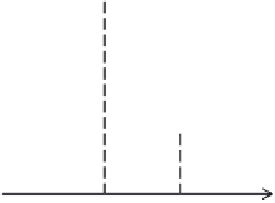Geoscience Reference
In-Depth Information
h
h
AorC
BorD
12
ξ
1
2
ξ
Fig. 7.2
Definition sketch for the analysis of the four types of abrupt surges.
type C and D, which result in a depressed water surface, the deeper leading edge flees
away from the more shallow water which follows behind more slowly; therefore, the
sharp front cannot maintain itself and soon spreads out: the wave is unstable. In spite
of these differences, the initial stages of all four types of waves can be analyzed in the
same way, as will be shown next.
Analysis of flood wave
The problem is most easily analyzed from a reference moving at the same velocity
c
s
as
the wave, so that the phenomenon becomes one of steady state. One may thus assume that
h
and
V
become functions of a single variable
ξ
=
(
x
−
c
s
t
) , and the partial derivatives
become ordinary derivatives as follows
∂
()
∂
d
()
d
∂ξ
∂
c
s
d
()
d
∂
()
∂
d
()
d
∂ξ
∂
d
()
d
t
=
t
=−
and
x
=
x
=
(7.1)
ξ
ξ
ξ
ξ
Because the velocity
V
and depth
h
vary markedly and abruptly across the wave, the inertia
and hydrostatic pressure gradient terms are predominant in the momentum equation
and, as a first approximation, the friction term
gS
f
and the gravity term
gS
0
can both be
neglected. In the absence of lateral inflow, the momentum equation for a wide channel,
(5.22), becomes then with (7.1)
V
)
dV
d
g
dh
d
−
(
c
s
−
+
=
0
(7.2)
ξ
ξ
Upon multiplication by (
hd
) and integration between two points 1 and 2, respectively,
some small but finite distance upstream and downstream from the abrupt wave (see
Figure 7.2), Equation (7.2) assumes the form
ξ
2
2
dh
2
d
V
)
h
dV
d
g
2
−
(
c
s
−
d
ξ
+
d
ξ
(7.3)
ξ
ξ
1
1
The same operations can be applied to the continuity equation for a wide channel, (5.13),
without lateral inflow. Thus, with the coordinate transformation (7.1), Equation (5.13)














